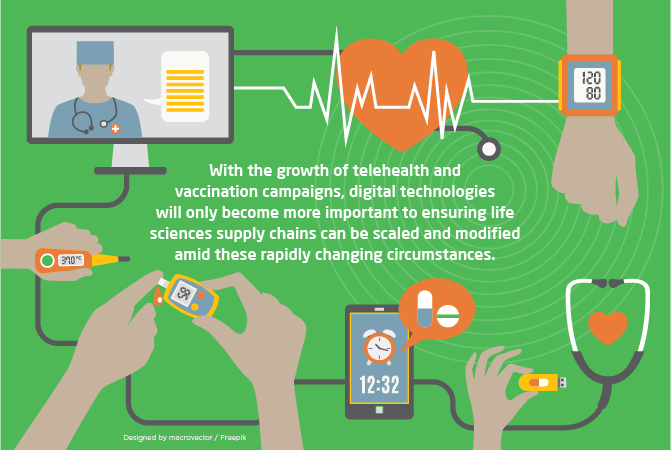The life sciences industry was in the public eye like never before in 2020. The rapid onset of the COVID-19 pandemic spurred a high-profile, worldwide quest to develop effective vaccines on a similarly quick timeline — and the effort succeeded, with multiple vaccines receiving regulatory approval before the end of 2020.
In 2021, pharmaceutical companies, as well as medical device firms, will continue to face challenges related to the coronavirus pandemic, in particular, and to the optimization of their supply chain operations, in general. Let’s look at some of the key trends across the industry for the coming year.
1. The increasing importance of cold chain visibility and traceability
The two earliest COVID-19 vaccines approved in the U.S. both have stringent requirements for cold storage. The Moderna and Pfizer vaccines must be kept at subzero Celsius temperatures during transport and have limited shelf life thereafter in refrigerators.
Accordingly, there is growing urgency around cold chain traceability, to ensure proper vaccine handling from manufacturing all the way through distribution. Such cold chain visibility was important before COVID-19 — for instance, to keep insulin at acceptable temperatures — so this trend represents an acceleration of something already in motion, rather than something entirely new.
Numerous technologies have emerged over time to enhance cold chain traceability in life sciences, including:
- Specialized barcodes and QR codes.
- RFID tags.
- Internet of Things sensors.
- GPS tracking.
- Near-Field Communication devices.
- Cloud-based software tools for managing the ensuing data.
These tools will become even more integrated into life sciences cold chains in 2021 and beyond. Annual sales of cold chain biopharma products could increase by $100 billion between 2020 and 2024 as demand ramps up and life sciences firms globalize their businesses.

2. Digital technologies come to the forefront of research and treatment
The life sciences sector has gradually moved toward cloud computing services as a way to streamline its IT costs and ensure proper infrastructure for more flexible and scalable operations. IBM has estimated that life sciences companies may be able to reduce their IT system costs by 25% through a cloud transition, although cost reduction is arguably the least important benefit of such a move.
More critically, cloud enables rapid data management and analysis, from a more streamlined, integrated and standardized technology stack than achievable with on-premise solutions alone. Digital technologies for AI, natural language processing (NLP), robotic process automation (RPA) aggregation and more are easier to implement and scale from the cloud, and these innovations will be important to the research and the monitoring of treatments in 2021.
For example, a pharma expert speaking to Drug Discovery & Development identified the use of AI and NLP as integral components of digital transformation in life sciences. These technologies can help:
- Gain insights during the discovery process.
- Speed up screening for clinical trials.
- Manage regulatory compliance at every stage.
- Integrate and analyze data from the patient end.
With the ongoing growth of telehealth and vaccination campaigns, digital technologies will only become more important to ensuring life sciences supply chains can be reliably scaled and modified amid these rapidly changing circumstances.
3. Accelerating development timelines and closer cross-industry collaboration
The COVID-19 vaccines followed exceptionally fast approval timelines. In 2021, life sciences organizations may look for opportunities to speed up the development of additional vaccines and other products.
The aforementioned digital technologies like AI and NLP may help, along with decentralized clinical trials facilitated by more collaborations between life sciences firms and contract research organizations. Treatments targeted at rare diseases, sometimes called “nichebusters,” may also become more common projects for drug makers.
Digital therapeutics, such as IoT wearables, could supplement medicines in more cases in 2021 and beyond, too. For example, armbands can gather patient vitals and analytics and assist in adherence to a treatment regimen.

Overcoming supply chain challenges in 2021
As the life sciences industry navigates these challenges and others in 2021, Inspirage can provide expert guidance and customized solutions across the supply chain. One such life science firm recently underwent the process of bringing internal processes and systems in line with GDSN standards. Organizational leaders wanted to implement a product data management solution that not only addressed current regulatory requirements from bodies like the NHS or FDA, but also positioned them to enter other markets and expand their capabilities as new regulations and customer requirements are released. Learn more about how Inspirage helped this organization, or contact a member of our team directly to get started on your next project.